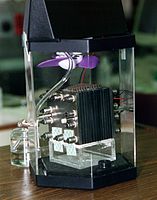
Photo from wikipedia
Prostate cancer is a life‐threatening condition worldwide. As the tumor progresses, smooth muscle cells (SMCs) become atrophic/dedifferentiated, within a series of stromal changes named stromal reaction. Here, we tested whether… Click to show full abstract
Prostate cancer is a life‐threatening condition worldwide. As the tumor progresses, smooth muscle cells (SMCs) become atrophic/dedifferentiated, within a series of stromal changes named stromal reaction. Here, we tested whether a laminin 111‐rich extracellular matrix (Lr‐ECM) could affect SMCs phenotype and differentiation status. Using time‐lapse microscopy, image analyses, quantitative real‐time reverse transcription polymerase chain reaction, immunohistochemistry and immunoblotting, and transmission electron microscopy, we showed that SMCs acquires a migratory behavior with a decreased expression of differentiation markers and relocation of focal adhesion kinase. SMCs set homotypic cell junctions and were active in autophagy/phagocytosis. Analysis of the migratory behavior showed that SMCs polarized and migrated toward each other, recognizing long‐distance signals such as matrix tensioning. However, half of the cell population were immotile, irrespective of the nearest neighbor distance, suggesting they do not engage in productive interactions, possibly as a result of back‐to‐back positioning. In conclusion, the Lr‐ECM, mimics the effects of the proliferating and infiltrating tumor epithelium, causing SMCs phenotypical change similar to that observed in the stromal reaction, in addition to a hitherto undescribed, stereotyped pattern of cell motility resulting from cell polarization.
Journal Title: Cell Biology International
Year Published: 2020
Link to full text (if available)
Share on Social Media: Sign Up to like & get
recommendations!